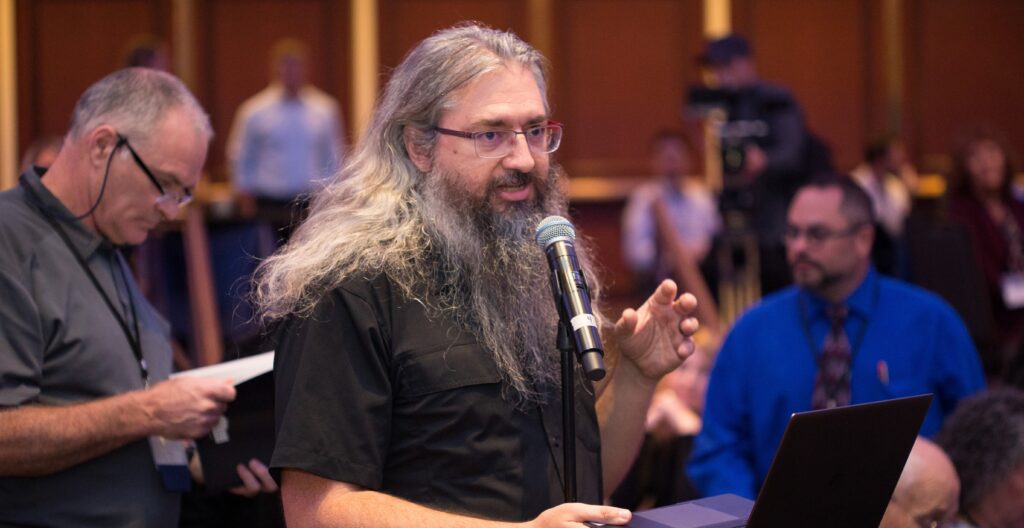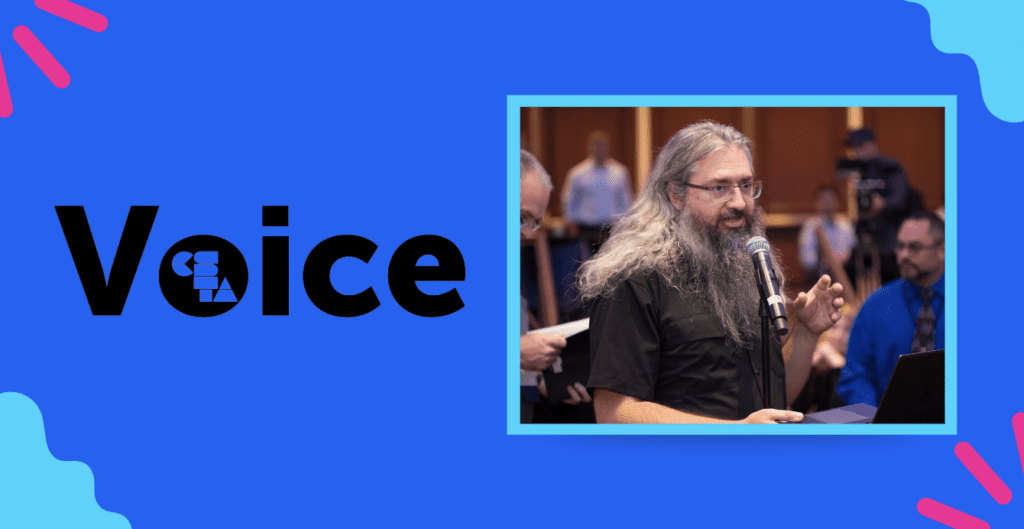
This is a CSTA partner post.
by The PAEMST Team
Christopher Bartlo, a 2017 Presidential Awardee from Oregon, has been making an impact on education, both inside and outside of the classroom, for 15 years. As a teacher, Chris developed a comprehensive, four-year Computer Science program for which students receive college credit. The program focuses on student-generated projects and connects students to industry professionals to foster work-based learning opportunities.
Earlier this month, we asked Chris to tell us what resources he uses to improve his teaching…
I tend to look outside the education literature to find resources to improve my own teaching. Lately I’ve been looking at User Experience Design, which has a rich body of work about identifying and meeting the needs of “users” in a broad sense. It is very applicable to teaching, and I think it is something that every teacher should spend some time learning. Another area of study that I think is a fantastic resource for improving your teaching is Game Design. Games have a phenomenal amount of learning theory packed into them and are a goldmine for ideas on how to engage learners. Jane McGonigal’s “Reality is Broken” and Jesse Schell’s “Art of Game Design” (particularly the “lenses” which are great for thinking about lessons/projects/activities students experience) have been great sources of inspiration for me.

As previously noted, Chris is a 2017 recipient of the Presidential Awards for Excellence in Mathematics and Science Teaching (PAEMST), the country’s top honors for K–12 STEM teachers. In 2019, Chris came to Washington, DC, with his fellow awardees to be recognized for the honor. To the right, Chris visits the White House with other PAEMST awardees.
The PAEMST award was established in 1983 and, in that time, has recognized over 5,200 teachers as awardees – up to two teachers per state and one per U.S. jurisdiction may win the award each year. The PAEMST application consists of a narrative, 30-minute classroom video, and more, which you can read about here. When asked about his favorite part of the PAEMST application process, Chris said:
While I always enjoy taking the time to reflect about my teaching, I had a particularly memorable time shooting my teaching video. I had arranged for one of my students who had an interest in documentary film to come to my class and capture video for my application. We had decided to film the whole class period and we were just going to use whatever section felt the most “natural” for what it was like being in a period of CS at Ida B. Wells (formerly Wilson) High School. After about 30 minutes of shooting, we all of a sudden got an active shooter alert over the PA system (thankfully it was just a drill). So, the whole class is sitting under the tables in the computer lab and my student films the whole thing (a brilliant decision because it was so authentic to our school). The drill ended and we went back to class and genuinely class went so amazingly well for that final 40 minutes – the students were so engaged and we got to capture all the cool project based learning that was going on in the space. In the end, to make the 30-minute video limit I had to include five minutes of us sitting under tables waiting for the active shooter drill to finish. I still watch that video about once a year because it has so many amazing little memories in it – the resilience of students, their passion towards their projects and learning… and honestly, I still marvel at how quickly everyone went from hiding silently to super engaged. Definitely the highlight of the application process for me.
Recently, Chris transitioned into a TOSA role for Career and Technical Education at Portland Public schools where he creates professional development and mentors new teachers. In particular, he has been collaborating on a mentorship program to support industry professionals transitioning to the classroom in STEM related fields. Chris works with local, state, and national groups to offer professional development for K–12 teachers who want to bring coding into their classrooms and is involved in planning the Oregon Game Project Challenge. When we asked Chris what his advice was for new teachers, he told us:
Investing in building classroom culture is the most important thing you can do. It is easy to overfocus on content/assessment/crafting perfect lessons/etc., but really the most important thing for students is that they understand your classroom is a safe space with clear expectations and you are someone who cares about their learning. The first step in this is being a genuine version of yourself in the classroom – students are keen observers of the discrepancies between how adults speak and act – being yourself builds a lot of trust. There are so many ways to do this and there isn’t a “best personality” that makes you an effective teacher. The second step is to take the time to think about how you want students to go about learning in your classroom and regularly get their feedback about how your class is working for them as learners. Simple check-ins with students (especially the ones who seem the most disengaged) will teach you a lot about what is working in your classes.
—
Do you know teachers like Chris? Nominate them for PAEMST or learn more about the award by visiting www.paemst.nsf.gov.

